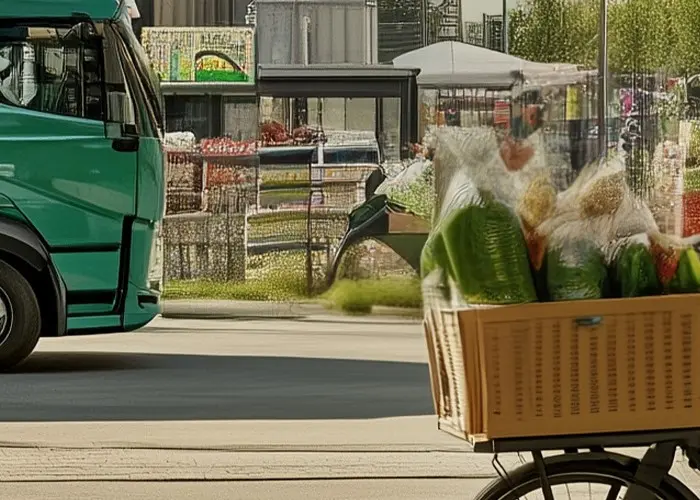- Insights & events
- Blog

Blog | December 12, 2024
How can grocery retailers thrive in the era of online sales?
In retail, customer convenience reigns supreme. Online sales have emerged as a transformative force across the retail landscape, including in grocery. The rapid growth of online sales channels, from traditional e-commerce platforms to quick commerce via e-bike delivery, is indicative of how consumers’ shopping for food and other daily necessities has changed. This shift presents both opportunities and challenges for grocery retailers striving to navigate this digital transformation.
The rise of online grocery retail
Developments in urban regions around the world show that e-grocery is not just a passing trend. Over 20% of sales in some regions are made via digital channels. While brick-and-mortar (B&M) is still the most profitable sales channel for grocery, its market share is shrinking.
Innovative start-ups are entering the grocery market with different online-only strategies and in some cases, large amounts of capital. Grocery shoppers’ preferences are changing as they get used to more convenient digital channels such as
- E-commerce: home delivery of grocery items stored in warehouses with large assortments
- Quick commerce: short-turnaround home delivery of grocery items stored in local micro-hubs with limited assortments
In the face of these trends, retailers must adopt effective strategies to secure market share and profitability in the short and long term. As demonstrated in our recent study “What’s the future of grocery retail?” , this goal is best achieved by actively gaining market shares in the e-grocery market and adjusting the brick-and-mortar footprint dynamically.
While digital channels enable businesses to cater to customer expectations, they also require specialized logistics networks of warehouses, micro-hubs and delivery vehicles. To ensure the profitability of these new channels, businesses must consider how to maximize efficiency. If grocery retailers can leverage economies of scale and ensure minimum throughputs, digital sales channels can have a positive effect on both profit margins and carbon emissions.
Achieving profitability in the future of grocery retail
A successful strategy must consider the costs and profit for each sales channel in realistic future scenarios. In omni-channel logistics, each sales channel requires different logistics processes and supply chains. That is reflected in the logistics costs for warehousing, handling and delivery.
In B&M, direct logistics costs often make up less than 1% of total costs. Delivery and warehouse processes are efficient, with optimized delivery of goods to multiple supermarkets using fully loaded trucks, and manual labor in warehouses is minimal.
For e-commerce, logistics costs account for 19% of overall expenses, our study found. In quick commerce, they amount to an impressive 31%. In these channels, delivery costs are higher, as each order requires individual pick-and-pack processes, most of which are done by hand. Some e-commerce pioneers have implemented automation for picking processes – an innovative but capital-intensive venture, often with long payback periods. On top of that, quick commerce involves costs for operating dark stores and expensive last mile delivery.
To reduce logistics costs of digital channels, businesses need a high order density. This is achieved through strong growth of digital channels and by attaining a high market share within a region, as well as choosing strategic locations for warehousing and distribution. This combination of requirements explains why many retailers active in digital channels are not yet profitable. But, as our study shows, businesses can achieve greater profitability with digital channels than in B&M given the continued growth of online sales and if businesses expand their share of the online market.
The higher the order density, the greater the profit margin for digital grocery channels
Optimizing the carbon footprint of logistics in grocery retail
Even purely margin-driven decision-makers must consider carbon emissions due to the impending associated costs. And online retail can contribute to greener retail, given the right circumstances.
In particular, the overall carbon emissions can be lower for digital sales channels than for B&M if the online market continues to grow and utilization of sites and delivery vehicles is high, as our study shows. This is because stores that lose customers to online channels become underutilized while still requiring indispensable resources like heating, lighting and personnel. As such, the emissions and costs for these stores rise per item sold.
As online channels grow, their carbon footprint shrinks. Optimized delivery routes in e- and quick commerce and well-utilized storage locations result in economic as well as environmental efficiency. This reduces the impact of private trips to supermarkets needed to bring the same amount of goods to consumers’ homes.
As a result, e-commerce can save around one third of CO2e emissions compared with B&M when digital channels account for 30% of total grocery sales.

Thriving in the future of online grocery retail
To thrive in the competitive landscape of online grocery retail, retailers must prioritize channels that deliver on customer expectations while still ensuring profitability. Actively participating in the e-grocery market is key for retailers to stay profitable in the future if digital channels maintain their steady growth. Creating efficient delivery networks with strategically located warehouses is another key element to meeting the evolving demands of consumers while maintaining profitability. Such efficiency gains can also reduce the carbon footprint of grocery retail operations, aligning sustainability and financial strategy.
Sound interesting?
Contact usInterested in more insights like this?
This article is based on the 4flow study “Sustainability, profitability and beyond: How can grocery retailers react to growing online sales channels?”. This resource offers an exclusive look at three strategies for grocery retailers facing this shift to online sales.
Authors:


Wendelin Gross
Head of
4flow research


Eric Breitbarth
Senior Expert
4flow research


